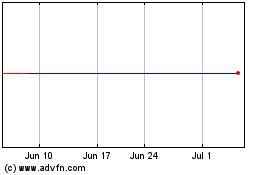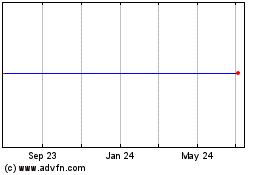Resonant Expands Licensing Agreement with Existing Tier One Customer
March 09 2017 - 8:30AM
Business Wire
Three New Designs Using Chip Scale Packaging
Targeting Difficult Bands
Resonant Inc. (NASDAQ: RESN), a designer of filters for radio
frequency, or RF, front-ends that specializes in delivering designs
for difficult bands and complex requirements, today announced it
has signed an additional licensing agreement with an existing Tier
One customer.
The new license agreement encompasses the development and
licensing of a TDD filter, a FDD filter and a Quadplexer, designed
using Chip Scale Packaging. All three are considered difficult
bands, and are targeted for the Chinese market.
- One of the designs will support High
Performance User Equipment (HPUE), which is used for increased
coverage at high frequency bands. Many device equipment providers
are now committing to delivering equipment that supports HPUE.
- Another is a WiFi co-existence filter
that protects WiFi while allowing cellular to work. With LTE
deployments increasing, filters that are capable of rejecting
closely adjacent frequencies are required to solve co-existence
problems.
- The Quadplexer is a completely new
design for Resonant, which we believe to be one of the hardest
Quadplexers on the market.
Design acceptance, milestone payments and royalty terms have
been agreed upon, but will not be disclosed due to the confidential
nature of such agreements.
“We believe this extension to our licensing agreement further
validates our customer’s confidence in our filter design
capabilities and their intentions to commercialize the filters we
are designing for them,” said George Holmes, CEO of Resonant Inc.
“These three filters focused on the massive Chinese market are
expected to help this customer broaden their revenue potential and
accelerate their growth. As our collaboration deepens, we look
forward to pursuing additional opportunities that have the
potential to further de-risk our path to revenue.”
Holmes, added: “Our pipeline of opportunities is being driven by
the industry-wide constraint on design capacity, the need for
rapidly evolving technology capabilities, and by wireless carriers
demanding higher data rates that is driving the increasing
complexity required by carrier aggregation. Looking ahead, the
emerging definition of 5G envisions dramatic performance
improvements in network capacity, mobile connections, latency,
cost, data rates and coverage. More bandwidth will be needed, which
will require higher frequency components, more carrier aggregation,
more complex multiple-input-multiple-output (MIMO) antennas, new
and adaptable waveforms, and improved interference mitigation. We
believe that by leveraging our ISN platform, Resonant will be
well-positioned to capture market share in this rapidly evolving
industry.”
These three designs are moving in the direction discussed in
Resonant’s whitepaper, “RF Innovation and the Transition to 5G
Wireless Technology,” which can be found on the Company’s recently
redesigned website at www.resonant.com.
About Resonant Inc.
Resonant is creating software tools and IP & licensable
blocks that enable the development of innovative filter designs for
the RF front-end, or RFFE, for the mobile device industry. The RFFE
is the circuitry in a mobile device responsible for the radio
frequency signal processing and is located between the device’s
antenna and its digital baseband. Filters are a critical component
of the RFFE that selects the desired radio frequency signals and
rejects unwanted signals and noise. For more information, please
visit www.resonant.com.
About Resonant’s ISN® Technology
Resonant can create designs for hard bands and complex
requirements that we believe have the potential to be manufactured
for half the cost and developed in half the time of traditional
approaches. The Company’s large suite of proprietary mathematical
methods, software design tools and network synthesis techniques
enable it to explore a much bigger set of possible solutions and
quickly derive the better ones. These improved filters still use
existing manufacturing methods (i.e. SAW) and can perform as well
as those using higher cost methods (i.e. BAW). While most of the
industry designs surface acoustic wave filters using a
coupling-of-modes model, Resonant uses circuit models and physical
models. Circuit models are computationally much faster, and
physical models are highly accurate models based entirely on
fundamental material properties and dimensions. Resonant’s method
delivers excellent predictability, enabling achievement of the
desired product performance in roughly half as many turns through
the fab. In addition, because Resonant’s models are fundamental,
integration with its foundry and fab customers is eased because its
models speak the “fab language” of basic material properties and
dimensions.
Safe Harbor / Forward-Looking Statements
This press release contains forward-looking statements, which
include the following subjects, among others: the capabilities of
our software tools and filter designs; belief in our customer’s
intention to commercialize our filters; the impact our filters will
have on our customer’s revenue potential and growth; and
developments in the wireless industry and the impact of those
developments on our market opportunities. Forward-looking
statements are made as of the date of this document and are
inherently subject to risks and uncertainties which could cause
actual results to differ materially from those in the
forward-looking statements, including, without limitation, the
following: our limited operating history; our ability to complete
designs that meet customer specifications; the ability of our
customers (or their manufacturers) to fabricate our designs in
commercial quantities; the ability of our designs to significantly
lower costs compared to other designs and solutions; the risk that
the intense competition and rapid technological change in our
industry renders our designs less useful or obsolete; our ability
to find, recruit and retain the highly skilled personnel required
for our design process in sufficient numbers to support our growth;
our ability to manage growth; and general market, economic and
business conditions. Additional factors that could cause actual
results to differ materially from those anticipated by our
forward-looking statements are under the captions “Risk Factors”
and “Management’s Discussion and Analysis of Financial Condition
and Results of Operations” in our most recent Annual Report (Form
10-K) or Quarterly Report (Form 10-Q) filed with the Securities and
Exchange Commission. Forward-looking statements are made as of the
date of this release, and we expressly disclaim any obligation or
undertaking to update forward-looking statements.
View source
version on businesswire.com: http://www.businesswire.com/news/home/20170309005255/en/
MZ North AmericaGreg Falesnik,
1-949-385-6449Greg.Falesnik@mzgroup.us
Resonant (NASDAQ:RESN)
Historical Stock Chart
From Mar 2024 to Apr 2024

Resonant (NASDAQ:RESN)
Historical Stock Chart
From Apr 2023 to Apr 2024
